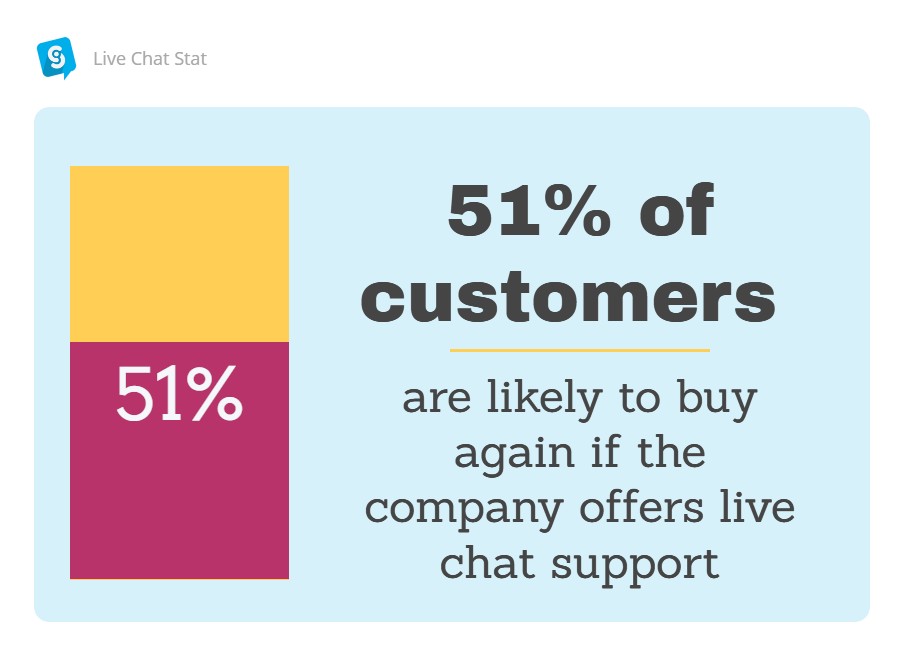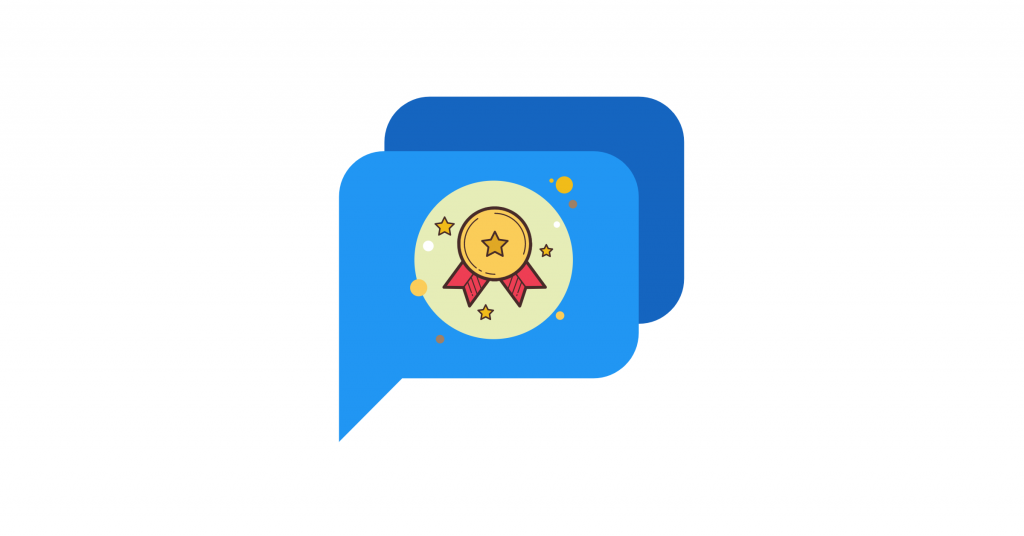Providing support through live chat doesn’t mean giving up the personal touch and connection that other support channels offer.
Website chat support enables businesses to engage with customers directly through their sites or applications, providing immediate responses to queries and concerns.
So, this method retains the personal touch and connection found in traditional channels, but with better speed and convenience.
In this article, we’ll explore the question “What is live chat support?”. We’ll go over its key benefits and outline best practices for implementing a successful live chat strategy.
What Is Live Chat Support?
Live chat connects customers and support agents, allowing them to interact in real-time through a live chat widget embedded in a website.
Supporting customers via live chat works similarly to other forms of real-time support communication. Users can use the live chat widget to send their questions directly to a support agent, who can then respond and address those customer inquiries within the same window.

Does Online Chat Support Actually Work?
Do customers engage with companies and seek their help through live chat? Absolutely.
The data clearly shows a strong preference and positive sentiment towards live chat support software:
- 42% of online customers prefer to communicate with a customer support team via live chat. The convenience of real-time customer service makes live chat a favored choice among users looking for quick resolutions.
- The average customer satisfaction rate for live chat services exceeds 87% within the tech industry. The ability to multitask and receive immediate assistance without the need for a phone call contributes significantly to a positive customer service experience.
- A survey noted that respondents who hadn’t used live chat were more likely to be infrequent online buyers, with 36% making a purchase less than once per month compared to 18% of chat users. These statistics highlight the impact of live chat on customer loyalty. By providing instant, personalized support, companies can use live chat software to foster long-term relationships.
Live support chat is a must-have communication channel for any brand. Embracing it not only meets customer expectations but also drives satisfaction, loyalty, and ultimately, business success.

What Is a Live Chat Agent and How Does Live Chat Software Help Them?
A live chat agent is a customer support representative who interacts with customers through live chat messages. Their role is to provide quick assistance, answer support questions, and resolve issues efficiently. Live chat software equips these agents with advanced features that help them deliver superior customer service.
Benefits of live chat for agents:
- Sharing links and pointing customers to relevant knowledge base articles: Live chat support agents can quickly share direct links to help articles, tutorials, or FAQs from the company’s knowledge base. This immediate access to resources helps resolve customer issues faster and empowers website visitors with self-help options.
- Utilizing a shared inbox and integrating with other communication tools: Live chat software often includes a shared inbox feature or integrates with other communication channels like Slack. This allows agents to collaborate with other team members or departments, bringing in additional expertise when needed to solve complex support tickets.
- Collecting information from customers: The customer service team can use live chat software to gather essential data from customers during the conversation. This can include contact details, order numbers, or specific issue descriptions. Collecting this information reduces the time needed to understand and address the customer’s concern.
- Leveraging data from the company’s CRM: Live chat software can integrate with Customer Relationship Management (CRM) systems, providing agents with access to valuable customer data. By reviewing past interactions, purchase history, and other relevant details, agents can gain a better understanding of customer needs and offer more personalized and effective support.
Why Is Live Chat Support So Important?
As you have probably gathered, live chat can provide a seamless support experience at every stage of the customer journey. Regardless of your company size, most businesses can benefit from this communication medium. Here’s why:
Live chat support aligns with how consumers prefer to communicate
Texting and messaging have become our go-to methods of communication:
- We discuss projects on Slack.
- We collaborate with colleagues and share ideas on Teams or other similar platforms.
- We can handle administrative tasks, update bank details, and more, all discreetly over chat.
- We chat with friends on WhatsApp, and so on.
We are more connected than ever, and our smartphones are no longer just for calling. They can perform nearly all the functions of a computer, including various forms of communication.
It’s no surprise, then, that many of us prefer to receive support through chat as well. We can easily resolve issues with a recent purchase by chatting with a support agent, whether we’re at our desk in the office or relaxing at home while streaming Netflix.
In today’s fast-paced world, live chat support aligns perfectly with our communication preferences, offering convenience, privacy, and efficiency.
Live chat support is easy to implement across all customer touchpoints
Adding a live chat widget to your website or app is straightforward and incredibly effective.
Customers can reach you directly from any page – whether that’s the home page, contact page, or checkout page – without having to search through your site’s navigation for support links. The widget pops up on every page of your choice, providing instant access to your support team with just one click.
This useful integration ensures that your customers can always connect with support effortlessly.

Live chat facilitates real-time conversations
While some may assume that live chat support lacks the personal touch of a phone conversation, this notion couldn’t be further from the truth.
Live chat enables customers and support agents to engage in real-time conversations, much like they would over the phone. However, live chat offers a distinct advantage:
It facilitates more focused and efficient interactions.
Unlike phone support, which can sometimes involve unnecessary small talk, live chat conversations are typically more targeted and concise. This communication format encourages both parties to get straight to the point, addressing the customer’s concerns or questions without beating around the bush.
It is precisely this efficiency that customers have come to appreciate about live chat support.
Moreover, the rise of emoji usage in live chat messages has further improved its ability to convey emotions and emulate body language. By incorporating emojis, support agents can add a personal touch to their conversations, making customers feel more connected and understood.

Live chat provides more context
One of the most significant advantages of live chat support is its ability to provide context-rich assistance to customers.
By design, this form of customer support seamlessly integrates with the customer’s product usage and user journey, allowing for a more personalized and effective support experience.
When customers encounter an issue, they often reach out to live chat support while actively using the product or navigating the website. This real-time interaction lets them seek assistance at the exact moment they need it, without having to switch between different platforms or communication channels.
Support agents can also see what the customer is doing within the product or on the website, providing them with a clearer understanding of the context surrounding the customer’s inquiry. This contextual information enables agents to provide more accurate and tailored guidance, ultimately leading to a faster resolution of the customer’s problem.
Live chat support is instant
While receiving a response to an email within an hour or two was once considered prompt and efficient, live chat has revolutionized the concept of customer support by delivering instant messaging and real-time assistance.
Customers no longer have to wait anxiously for a reply or wonder if their message has been received. Instead, they can engage in a conversation with a team member immediately, receiving answers to their questions and solutions to their problems in a matter of seconds.
This instant gratification is a key factor in the growing popularity of live chat as a preferred support channel.
Live chat support is highly scalable
One of the main drawbacks of call center support is that an operator can only conduct one conversation at a time. This means that when a customer calls in with a question, they must wait in a queue until an agent becomes available. Depending on the volume of calls and the complexity of the issues, customers may find themselves waiting on hold for an extended period, leading to frustration and dissatisfaction.
In contrast, live chat solutions allow agents to handle multiple customer conversations simultaneously. By leveraging the power of multi-tasking and the efficiency of written communication, live chat agents can engage with several customers at once, addressing their concerns and providing solutions in a timely manner. This reduces wait times and increases the overall output of the support team.
Live chat support also enables agents to utilize canned responses for common queries. These pre-written, standardized responses can be quickly customized and sent to customers, saving agents valuable time and effort.
How Do Live Chats Work?
When considering adding live chat to your website, it’s essential to formulate a plan that addresses key aspects of the implementation process. Here are four critical questions to help guide your strategy:
Do you need to launch live chat support for all customers? The logical answer is yes. But think about it. You’re launching a new live chat support channel. Implementing live chat support requires time to develop relevant processes and find your footing. To ensure a smooth transition, consider starting with a selected customer segment, such as your best customers.
- What are your expectations for this support channel? Clearly defining your goals is crucial for focusing your efforts on the right actions and measuring success from the start. For example, if your primary objective is to provide instant customer support, prioritize monitoring and improving your live chat response rates.
- Can you provide live chat support throughout the entire day? When launching a new support channel, it’s important to assess your existing resources and capabilities. If you don’t have a dedicated team to manage live chats, consider whether your current staff can handle it alongside other support channels. Evaluate your manpower and determine if you have sufficient resources to provide full-day coverage. If not, consider offering live support during set business hours initially, and expand the coverage as your team grows and becomes more efficient in handling multiple channels simultaneously.
- What is your current communications workflow? In other words, how do your teams communicate and collaborate? Are they using any specific tools, like Microsoft Teams or Zoom? Seamless integration with your existing communication tools and workflows is key to a successful live chat implementation. This way, your teams wouldn’t have to learn new tools, greatly reducing the amount of time required to get them up and running. Once you’ve addressed these questions, you can embed live chat on your website. Check out our step-by-step guide to get started in just a few minutes.
Best Practices for Live Chat Support
Now that we’ve covered the essentials of implementing live chat support, let’s dive into some best practices to help you take your customer service to the next level:
Make live chat easily accessible
To prevent customers from abandoning your site due to difficulty finding assistance, make your live chat option easily discoverable:
- Place the chat widget on every page of your website.
- Use proactive triggers to display welcome messages to new visitors.
- Ensure the chat widget is visually distinct and optimized for mobile devices.
- Provide clear instructions on how to initiate a chat.
- Integrate live chat with other support channels for a seamless experience.
Set up away messages and auto-responses
When you can’t be online 24/7 to respond to live chat inquiries, setting up away messages and automated responses can help manage customer expectations and maintain a positive experience:
- Set clear working hours: Inform customers when they can expect a response by adding your live chat support hours to your website or chat widget. Be transparent about any differences in responsiveness during weekends or off-hours.
- Use away messages: Configure your live chat system to display away messages when you’re offline. These messages should clearly state when customers can expect a reply, such as “We’ll get back to you first thing Monday morning!”
- Provide auto-responses for common questions: Implement automated responses to address frequently asked questions or provide links to helpful resources. This ensures customers receive instant assistance even when agents are unavailable.
- Follow through on your promises: If your away message states that you’ll respond on a specific day or time, make sure to follow through. Prompt replies during your stated working hours are crucial for maintaining customer trust and satisfaction.
Build a library of canned messages
To provide consistent support, consider building a library of canned responses for frequently asked questions (FAQs):
- Identify common inquiries: Review past live chat conversations and identify the most commonly asked questions or issues.
- Draft clear, concise responses: Create canned responses that address these questions directly, providing accurate information and solutions. Ensure the responses are clear, concise, and aligned with your brand’s tone and voice.
- Personalize the interaction: While canned responses save time, it’s crucial to maintain a human touch. Encourage agents to personalize the responses as needed, adapting them to each customer’s specific situation.
- Regularly update and refine: As your products, services, or policies change, make sure to update your canned responses accordingly. Continuously gather feedback from your support team and customers to identify areas for improvement.
NOTE: Canned messages are meant to supplement, not replace, human interaction. They serve as a starting point for providing quick, accurate information, but agents should always be prepared to offer personalized assistance when needed.
Track your live chat response time
Measuring and benchmarking your live chat response rate is crucial for assessing your team’s performance and identifying areas for improvement:
- Establish a baseline: Start by measuring your current average response time. This initial measurement will serve as a benchmark to track your progress over time.
- Set goals: Based on your benchmark, set realistic goals for improving your response time. Consider factors such as your team’s capacity, the complexity of inquiries, and industry standards.
- Monitor and analyze: Regularly monitor your response time and analyze trends. Identify patterns, such as peak hours or common bottlenecks, that may impact your team’s efficiency.
Ask customers for feedback
Your customers have first-hand experience with your support team and can provide valuable insights into what’s working well and areas that need improvement. Here’s how you can effectively gather and utilize customer feedback:
- Implement post-chat surveys: Add a brief survey or poll at the end of each live chat session. This can be as simple as asking customers to rate their customer experience on a scale or providing a few quick questions about their interaction with your support team.
- Keep it concise: Respect your customers’ time by keeping the feedback process short and focused. Aim for a survey that takes no more than a minute or two to complete, and only ask questions that will provide actionable insights.
- Vary your questions: While a simple rating scale can provide a quick snapshot of the customer experience, consider including open-ended questions that allow customers to share more detailed thoughts and suggestions. This qualitative feedback can offer valuable context and help identify specific areas for improvement.
- Analyze the feedback: Regularly review and analyze the feedback you receive. Look for patterns or common themes in customer responses, and use this information to guide your support team’s training, processes, and priorities.
Transform Your Customer Support With Live Chat
After exploring the question “What is live chat support?”, it is clear that it is a powerful tool that enables businesses to provide instant, personalized, and efficient customer service.
However, simply adding it to your site isn’t enough. To make the most of it, it’s essential to implement best practices such as ensuring accessibility, setting clear expectations, utilizing canned responses, and actively seeking customer feedback.
If you’re looking to implement live chat support or enhance your existing setup, consider using Social Intents. Our platform offers a range of features specifically designed to help you deliver exceptional live chat support, including customizable chat widgets, proactive triggers, and integration with popular tools like Slack.
With Social Intents, you can easily manage and optimize your live chat support, ensuring that your customers receive the timely and personalized assistance they need.
Get started with our free 14-day trial today.


